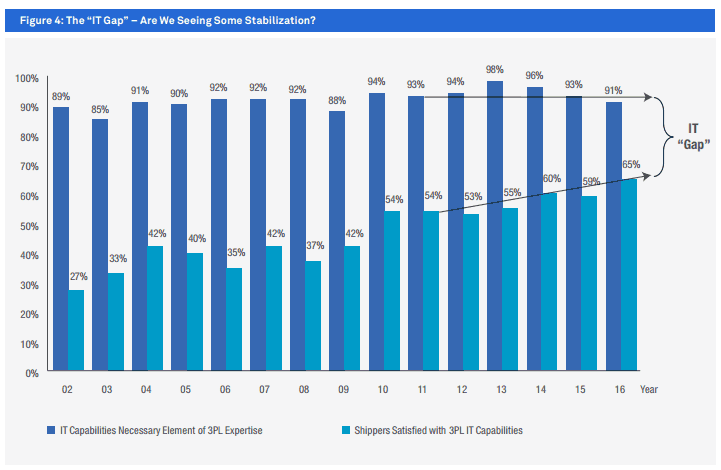For the 21st consecutive year, Dr. John Langley of Penn State University has led the annual Third Party Logistics Study, released again this year at the CSCMP conference in Orlando two weeks ago, a collaboration between Langley, Capgemini Consulting, and lead sponsor Penske Logistics.
The data, based on survey responses from 350 shippers and 3PLs each worldwide, doesn't usually change all that much from year to year, but some overall trends are clearly discernible, and once again this year the study delved into some special focus areas such as Big Data and supply chain transformation that provided new insights.
For many years, the study has supplemented the survey data with a small number workshops where shippers and 3PLs came together to discuss key issues, but that activity did not occur for this edition of the report due to health and security concerns.
Supply Chain Digest Says... |
 |
Fewer 3PL users report reducing or consolidating the number of 3PLs they use - an average of 47%, compared to the previous year's reported 57% and 53% the year before that.

|
What do you say? |
| Click here to send us your comments |
 |
| Click here to see reader feedback |
|
|
This year's report comes in at a hefty 60+ pages, and frankly from SCDigest's point of view the report authors got a little carried away in terms of the amount of text. The full report is available for free download here, but we will summarize highlights this week and next for those not wanting to wade through the full document.
We will first note the survey is a global one, though 65% of this year's respondents were from North America. 16% of respondents came from Europe, and another 11% from Asia. Unlike some previous reports, this year's study does not really break out any of the survey results to show differences in responses by region.
The report notes several trends that are impacting shipper-3PL relationships. One of the most prominent is the continuing level of consolidation in the 3PL sector, as firms there look to fill gaps in service areas,
expand their global networks, and leverage best
practices and technology across a global scale.
The report also reports that the value of global M&A deals in the 3PL sector nearly doubled from
2014 to 2015, growing to $173 billion last year from $87
billion the year before.
The activity has been especially hot in cross-border deals (3PLs headquartered in one country buying a firm in a different one). The value of such deals quadrupled from $28 billion in 2014 to $115 billion in 2015.
That naturally enough has many shippers concerned about a reduction in competition and too much pricing power in the hands of ever larger 3PLs. In fact, 34% saying that they are
concerned about reduced competition from the merger activity, with another 31% worried about the loss of personalized service that small providers offered. That said, 27% believe that the M&A brings added
options and versatility from providers that are
good for shippers.
Interestingly, the report notes data from Armstrong & Associates that found total spending on 3PLs actually declined a bit in 2015, coming in at $721 billion worldwide versus $751 billion in 2014. The cause? Not clear, though most likely the weak economies across many parts of the globe is the key driver of the decline.
The news was a bit different in North America, where spend on 3PLs, was up about 1% in 2015. Over the last 10 years, 3PL spending on average has risen about 4% annually in North America, and 4.8% on a global basis.
The report also says more shippers are becoming less concerned about using a specific mode of transportation and instead are opting for
the most efficient means of moving products across modes. That, the report says, "has resulted in the growth of mode-neutral
logistics providers, and 3PLs are using data
aggregation and analysis to determine the best
shipment methods."
The survey found that more than half of 3PLs -
62% - said that over the past two to three years,
their customers have shown interest in changing
their use of various modes of transportation.
SCDigest is always interested in the dreaded "IT Gap," which the report has been following for many years. That gap refers to the percentage difference between how shippers place 3PL IT capabilities in terms importance (always very high, usually in the low 90s in terms of percentage), versus their view of actual 3PL IT capabilities, always much lower a score.
But as can be seen in the chart below from this year's report, that gap has been closing fast in recent years, and is at its lowest level ever.
3PL "IT Gap" is Closing Fast

Source: 2017 Third-Party Logistics Study
(See More Below)
|
CATEGORY SPONSOR: SOFTEON |
|
|
| |
|
|
 Other highlights of this year's survey results include the following: Other highlights of this year's survey results include the following:
• 58% of shippers indicate they
are increasing their use of outsourced logistics
services this year, which compares to a figure of
73% reported last year. There is no clear reason for the drop, and SCDigest believes that it is most likely a statistical aberration. Only 26% of shippers indicate that
they are returning to insourcing many of their
logistics activities, which is lower than the 35%
reported last year.
• This year,
fewer 3PL users report reducing or consolidating
the number of 3PLs they use - an average of 47%,
compared to the previous year's reported 57% and 53% the year before that.
• 88% of respondents use 3PLs for domestic transportation management, by far the highest service area. That was followed by warehousing services at 66%, and global transportation management at 60%. Just 10% of respondents said they use a lead logistics provider/4PL type of arrangement.
• Users of 3PL services report about 50% of
their total logistics expenditures are related
to outsourcing, which is the same amount
as reported last year. The percentages reported
in preceding years were significantly lower.
• Among shippers, 16% said they contract
to a delivery timeline and dates and let a
logistics service provider decide how to
best meet expectations. Another 16% said
they don't contract by specific modes and
instead look for providers that offer more
than one option.
Next week, we will look at some of the data and commentary in the report's special focus topics, such as the role of 3PLs in supply chain transformation, Big Data and advanced analytics, and the end-of-life supply chain.
Any reaction to the data summary of this year's 3PL study? Is the "IT Gap" really closing - and why? Let us know your thoughts at the Feedback section below.
Your Comments/Feedback
|